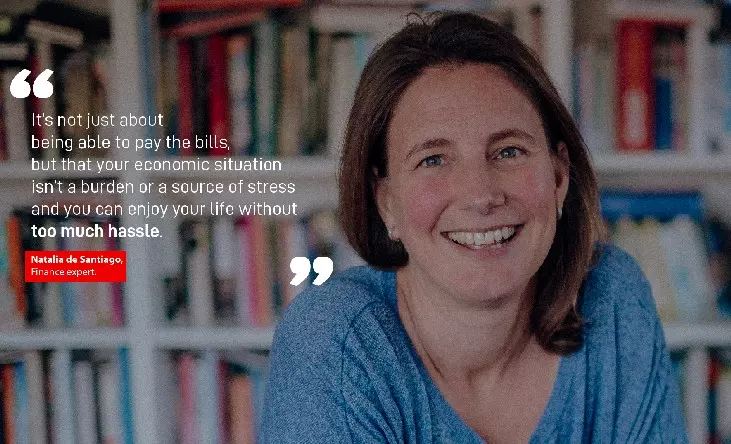ECONOMY| 06.07.2022
Tips to take care of your financial health with Natalia de Santiago
Today we have the pleasure of talking toNatalia de Santiago. Natalia is an engineer by training, a financier by vocation and she specializes in the economic impact of climate change. You have always worked in finance. You have been based in Paris, Madrid and Munich, and in 2009 you co-founded MyValue Solutions, a pioneering company in the design of open banking solutions that was acquired by a German group in 2021.
She also writes about finance and economics for Elle magazine, and spends more time on Instagram than she should, and lives tucked away in the Alps with her husband and five daughters. Yes, you read that right: five daughters. In 2021 she published her first book, “Invest in Yourself,” to bring the world of economics and finance closer to ordinary mortals. She recently released her second book “Invest just a little, make your money grow,” thus continuing to publish interesting content on financial education suitable for all audiences.
We will talk with her about her tips for taking care of our finances, but to begin we will revisit this concept that is so often repeated, but so difficult to define at the same time: financial health.
Could you describe what we mean by financial health?
Having good financial health means being able to meet your needs with no problems, but also having the security that you will be able to continue to meet your needs in the future and have the opportunity to make decisions that will allow you to enjoy life.
It’s not just about being able to pay the bills, it’s about making sure that your financial situation is not a burden or a source of stress and allows you to enjoy a stress-free life.
And how can we know if we are in good financial health? What are the key indicators?
Looking at the numbers. At the end of the day, we financiers are like a doctor and just as we measure your cholesterol levels, there are certain financial ratios that we can measure to know how we are doing in terms of financial health. The most basic indicators, such as your emergency buffer, debt ratio and savings capacity, among other things, already give us many clues about a person’s financial health.
Natalia uses some financial terms to explain the key indicators for good financial health, and if there are still people who do not know them, we will explain them to you:
The emergency buffer, also known as an emergency fund, is the amount of money you should have saved before investing your money. This allows you to deal with unforeseen events or any losses with a certain peace of mind.

Further, Natalia also mentions the debt ratio, or the indebtedness ratio. It is a financial index used in accounting to determine how much of a company’s assets are financed with debt. This data is useful to see the external financing available to a company and its own resources.
Finally, she also speaks of saving capacity, which, simply put, is people’s ability to set aside a percentage of their income for future use, as long as doing so does not mean any deterioration or compromise in their current quality of life.
In your first book you argue that “not all debt is bad.” When and why is it healthy to incur debt?
Debt can be a lever to help you grow. For example, by helping you buy a house, start a business or pay for a master’s degree that will allow you to get a better job.
But it can also be very dangerous, which is why it is very important to learn to distinguish between healthy debt that can help you grow and poisonous debt, which only makes you pay more money for the same things and encourages you to spend more than you should on things that will neither help you increase your earning capacity or grow your assets.
How did you decide to dedicate yourself professionally to the world of finance after studying engineering?
The truth is that the more technical side of engineering never captured my imagination during my degree years. I passed the exams, but transformers and pulleys didn’t mean anything to me. That was until we started looking at cost and management subjects and then my brain clicked. Those numbers did speak to me. That’s why, already during my college years, I started working in finance and haven’t looked back.
Moving on to personal finance tips, can you explain to us how you can save, for all those people who find it difficult to make ends meet? How much should be allocated to savings?
In a deliberate, intentional way. That is to say, proactively. Without waiting to see if there is anything left in the account at the end of the month. The ideal is to set a realistic amount and do it at the beginning of the month, as soon as you receive your salary, and automatically with a scheduled transfer to the savings or investment product of your choice.
When things are going reasonably well you should try to save at least 10% of your net income. If it can be more, so much the better, but with 10% you are off to a good start.
And if we talk about what we do wrong, can you tell us what are the most common mistakes people make in financial matters?
What we were talking about, seeing savings as what’s left in the account at the end of the month and, in general, having a passive attitude as if finances were something external over which you have no control.
It is true that there are situations that we cannot determine, but there are many things that we can do to improve our economic situation and to make things that are beyond our control affect us less. The sooner you take control of our finances, the better off you will be.
Of all the tips you explain in your books, which three would you highlight for anyone who wants to improve their personal finances?
First, understand that the saving is one of the most powerful tools we have at our disposal to live a better and more peaceful life. Then, realize that in money matters, time is equally or more important than quantity and that it is important to always think in the long term. And, above all, do not underestimate the power of small quantities. Consistency is essential in finance because, in the end, many little things do add up.
What recommendation would you give to those who are afraid to invest but want to start doing so?
Let them start small and go bit by bit. As we were saying, in investment we don’t need either large amounts or stratospheric returns, but time. Small amounts and modest returns can give us a great result thanks to the multiplying power of compound interest. Really, the only thing we need to give our savings a good boost is time.
Lastly, we’d like to hear more about your latest book. How did you come up with the idea of writing your second book “Invest just a little, make your money grow”? Who is it for?
It is a book for all audiences. You don’t need any prior knowledge and you don’t have to be a mathematical genius.
The idea came from the previous book, Invest in You, in which I explained eleven steps to improve your finances. Of those eleven steps, one of the last ones was investment. But, because it was only one chapter, it was not explored in depth and many people, when they finished it, asked me for recommendations to continue reading about this topic because they wanted to keep learning.
And that is precisely what I have tried to do in Invest just a little: to answer all the questions about investing that people ask me every day on social networks.
Thank you very much, Natalia! It has been a pleasure to have you to talk about financial health and personal finance, two topics that MAPFRE likes to join efforts to achieve the goal of two of the Sustainable Development Goals: No poverty and quality education. And to speak of quality education also means to speak of financial education, which allows you to make the best decisions that can determine your future. For this reason, at MAPFRE we promote financial and insurance education and culture among our stakeholders: our employees and society in general.
At MAPFRE we care about what matters to you, and our Sustainability Strategy allows us to continue doing so. We are working to make quality employment, inclusion, financial education, accessibility to insurance, and the sustainability of our value chain the drivers of transformation to achieve development that is sustainable, fair and egalitarian for all.
RELATED ARTICLES:





